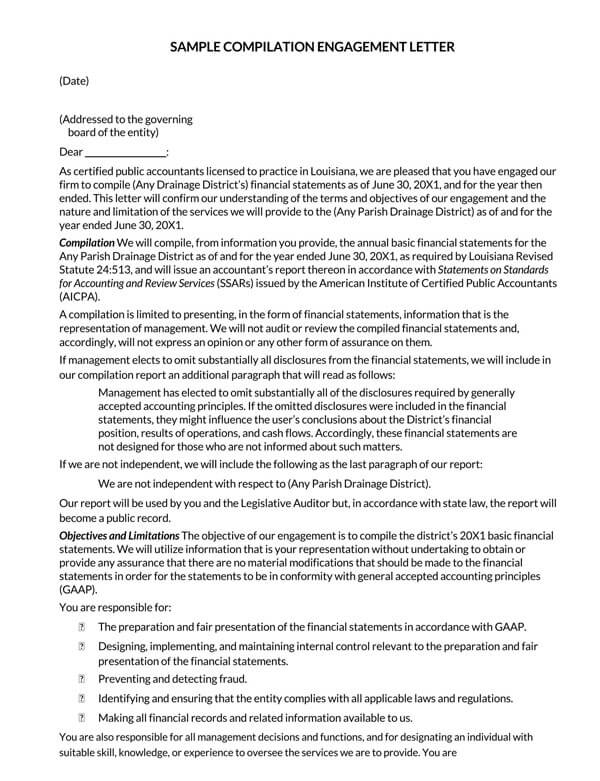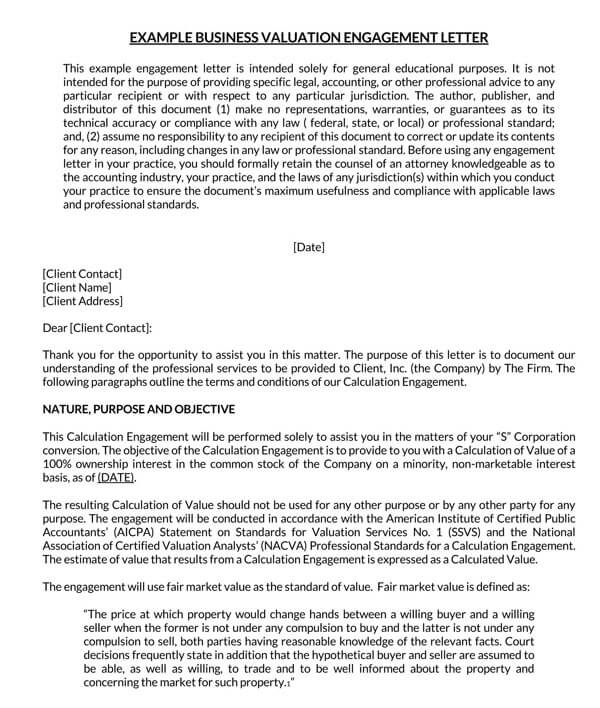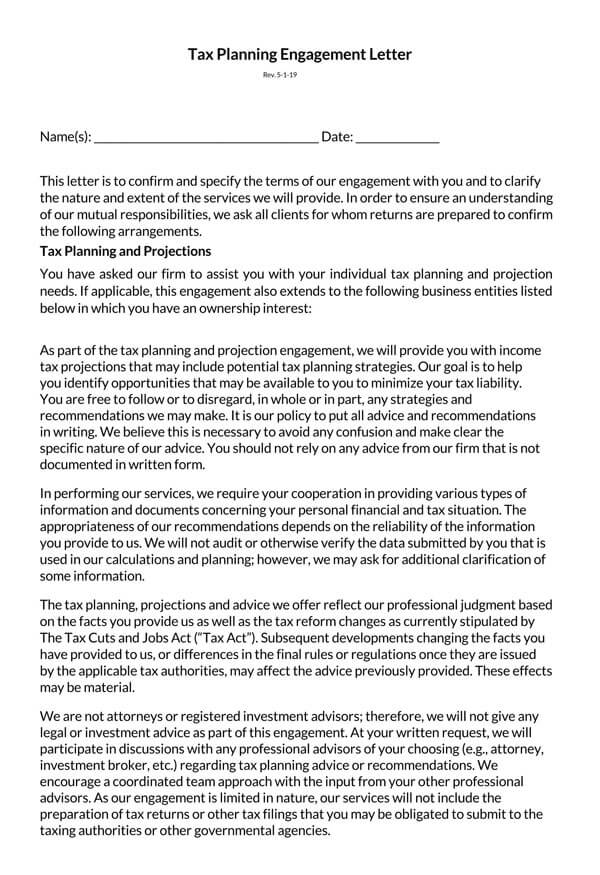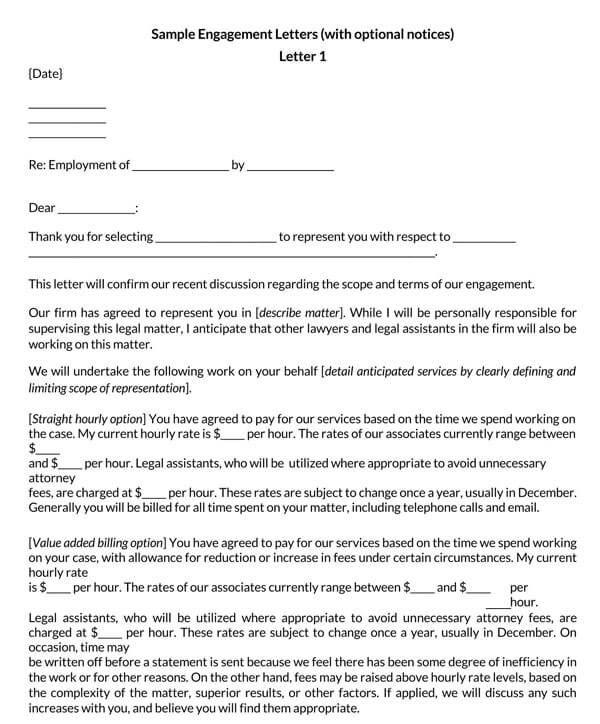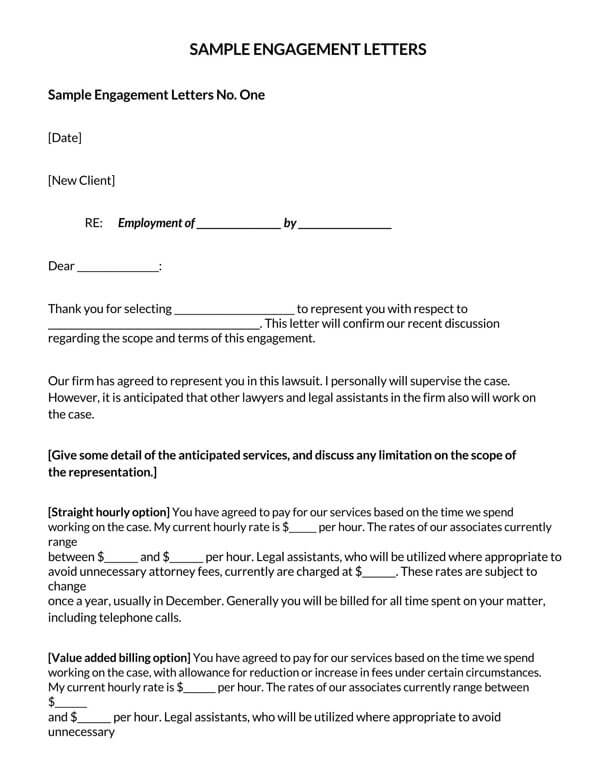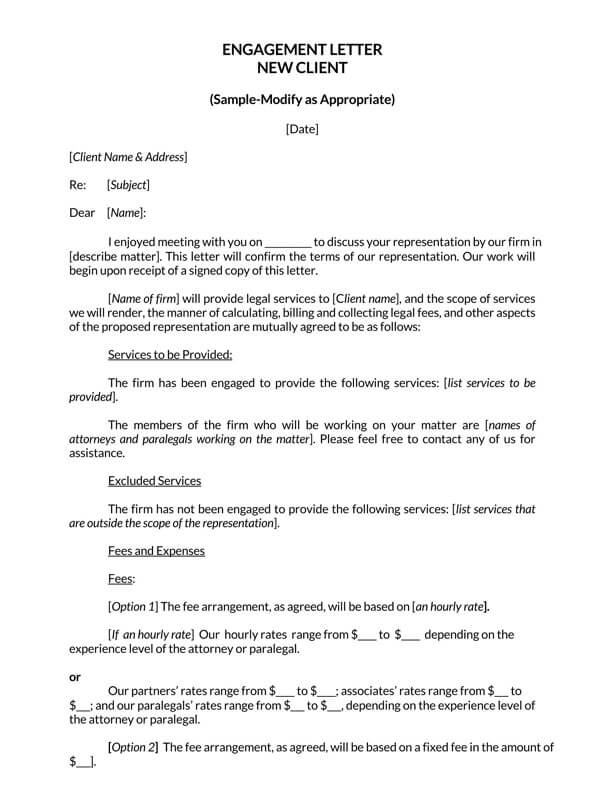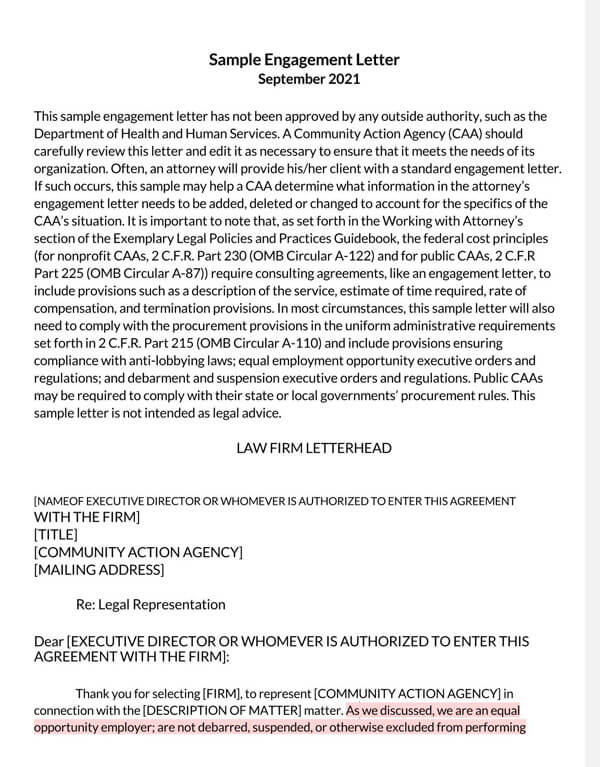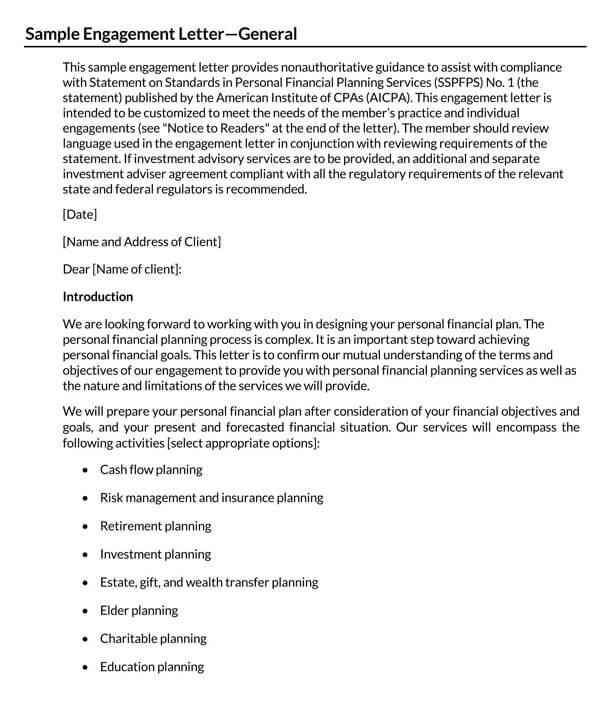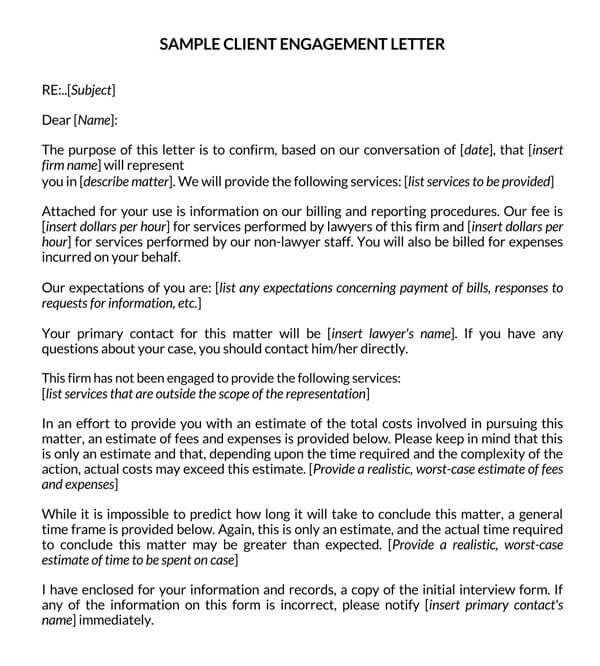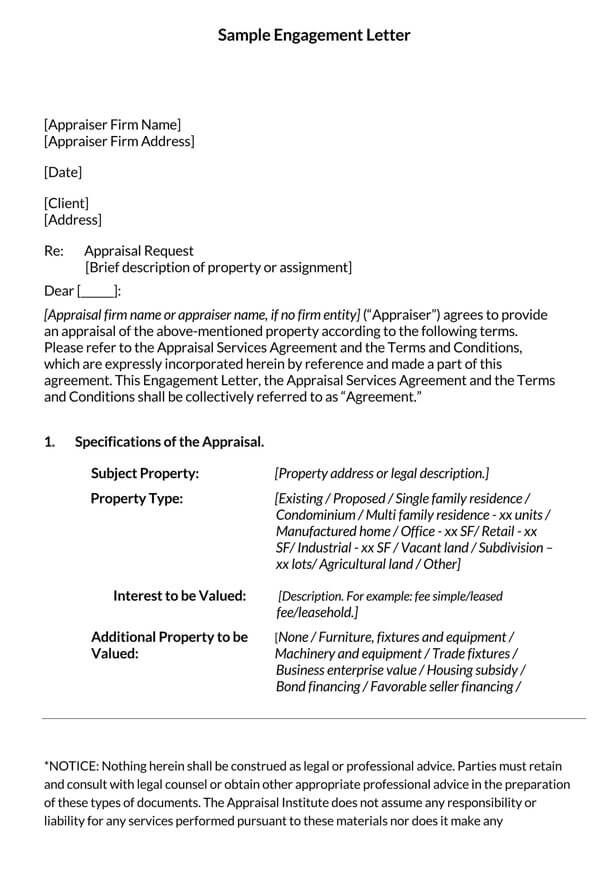An Engagement Letter is a formal letter that acts as a legally binding document between a client and a third-party consultant.
The document highlights the type of work being offered by the professional and the amount to be paid by the client.
Licensed professionals usually require an engagement letter to help identify their relationship with the client according to the State laws and fulfill their compliance policies.
The letter is meant to briefly and accurately relay the project or services that are to be delivered, the deadline for the services, and the compensation. The basic components of this form include the scope, fees, and responsibilities of both parties.
Some of the professional services that utilize this engagement letter include bookkeepers, lawyers, accountants, attorneys, and real estate agents. With an engagement letter, the two parties are bound to perform their expected parts and uphold the agreement terms as mentioned in the document.
Get Help from Engagement Letter Templates
A professional looking to prepare an engagement letter can get help from engagement letter samples and templates found online. They can download the letter as Adobe PDF or an MS document. With the samples, a professional can be sure that all the components are present and filled in before them and their clients sign the document.
The engagement letter samples also act as examples in case a professional decides to write their own engagement letter instead of using the templates already provided.
Following are some free downloadable templates for you:
What is a Retainer?
A retainer is defined as the amount paid as an advance by the client to the third party consultant for the services being offered but yet to be completed.
It is usually part of the engagement letter since it signifies the commitment of the client regarding the deal at hand between them and the professional third party. A retainer also acts as a security deposit for the professional offering their services.
Note: Although an engagement letter does not fall under a formal contract, it can still be used in a court of law since it is a legally binding document. That means both parties who sign it must uphold all that was agreed upon.
How the Engagement Letter Works
Any firm that offers professional services must prepare an engagement letter. It remains valid for the period of time mentioned, and both or either party can choose to exit out of the agreement.
Here are the details of how an engagement letter works. Engagement letters, once crafted and signed by both parties, provide clear details of the type of services the professionals are offering their clients. In case the professionals are offering various services, then they will have to prepare multiple engagement letters.
Since an engagement letter can remain valid for a long period, the third-party consultants and their clients are advised to review it on a yearly basis. This way, all the terms of the agreement will continue to be upheld, and updates on the document can be made appropriately. Finally, either the professional third party or their clients can opt-out of the agreement based on the conditions of the termination clause included in the letter.
Types of Engagement Letters
There are three types of engagement letters used by different professionals who require this document.
They include:
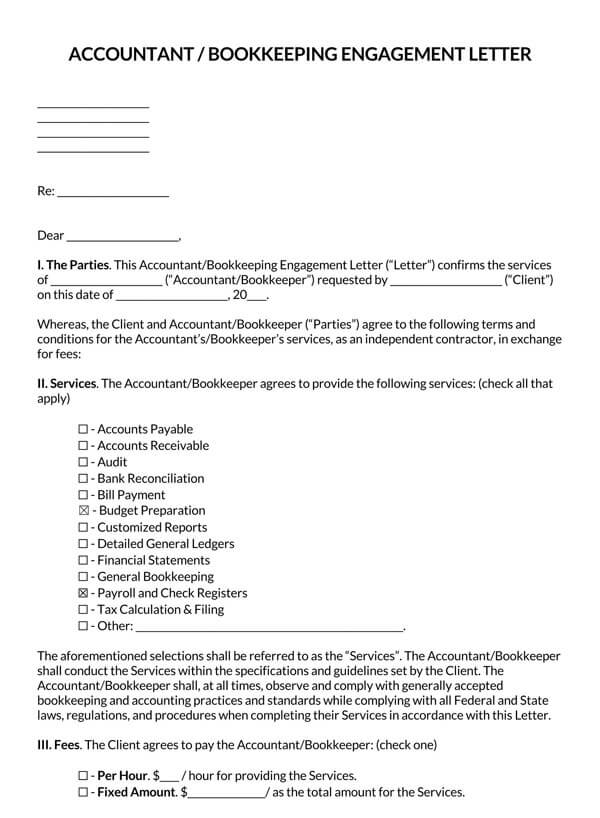
Accountant Book keeping Engagement Letter
This engagement letter is used for bookkeeping. It can also be used for accounting purposes like tax filing and audit consulting services for individual clients or businesses.
It usually highlights the scope of the work to be provided by the third party, including the timeline and the compensation to be made by the client. In addition, according to their professional liability insurance, both accountants and bookkeepers should have a signed engagement letter before they begin their work.
Download: Microsoft Word (.docx)
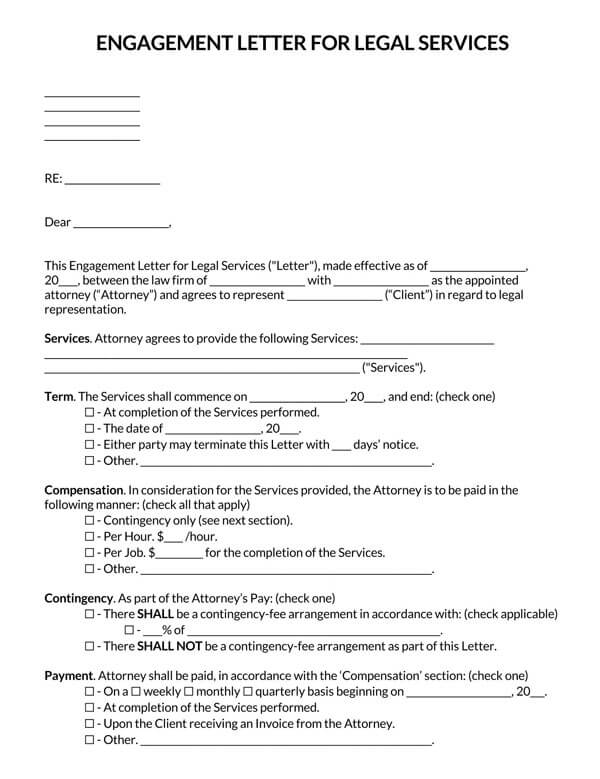
Attorney engagement letter
Legal professionals utilize this engagement letter to detail the services they will perform on behalf of their clients.
With this letter, a client can hire another client to offer them legal services. Both parties will have to discuss the extent of the work to be done and the payment, which is usually pair per hour. An attorney or lawyer usually requests a retainer, which acts as the advance payment for future services, before they can begin offering their legal services.
The attorney later on bills the client through an invoice once the work is completed.
Download: Microsoft Word (.docx)
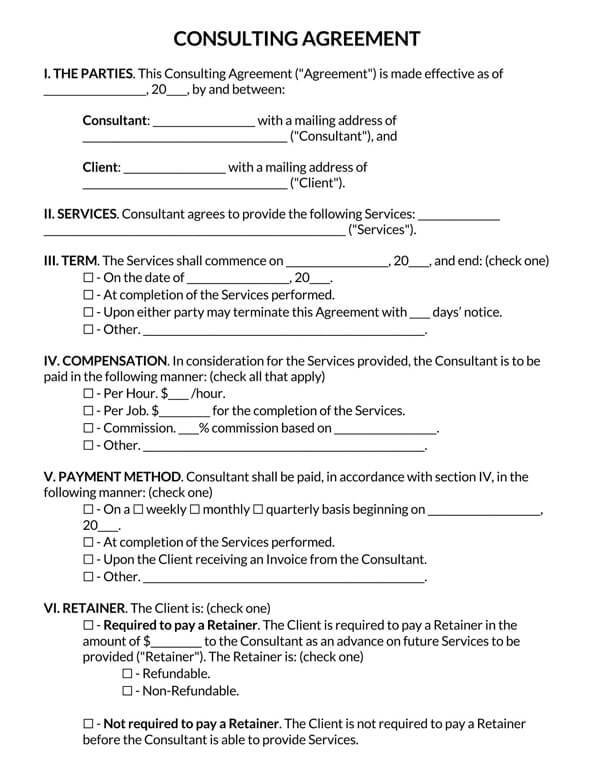
Consultant engagement letter
This engagement letter is designed to be used by professionals who offer consultancy services aimed at sharing their expertise in a particular field with their clients.
With this engagement letter, the client usually deals with a professional who will offer them services, advice, or knowledge in a certain area in exchange for money. The professional, in this case, tends to be an expert with great knowledge and experience in that field.
Download: Microsoft Word (.docx)
Components of an Engagement Letter
Although engagement parties may be different from each other, professionals should ensure that the engagement letter they prepare contains certain components before the signing of the document takes place.
These are:
Details of both parties
Information regarding the parties to the agreement should be clearly indicated in the engagement letter. Both the professionals’ and the clients’ details, including the names and addresses, are essential and must be highlighted first in the document.
Both parties should also include their signatures and the date of signing the engagement letter at the end.
The professional should open the engagement letter by greeting the client and being thankful for the business offer. They should first identify their name, their position, or job, then present their work proposal.
For example:
“I, Albert Leo, a qualified bookkeeper in the State of Massachusetts, propose to complete the project stated below for QRZ Company.”
Types of service
Whether it is accounting services, bookkeeping, or legal services, the type of service being offered to the clients should be well-included in the letter.
The professional should specify the type of service they are proposing to deliver, the payment process, and when they send the invoices to their client. The client should have the proper information in regards to what exactly the professional will do and what they will not do. It is best to list the tasks in bullet form to be sure about all the services expected or promised.
Specific service detail
After mentioning the type of service being offered, it is also important for the professional to provide clear and specific details of the services to avoid misunderstanding. This way, the amount to be paid for services offered, the quality of the services being offered, and the deadline for offering the service can be easily included in the engagement letter.
For example:
If the professional firm is offering accounting services, this section should specify which kind of accounting service it is, which may be auditing or filing taxes.
The engagement letter should also include the duration of the tasks by highlighting the due date. This way, both parties can mark this date on their calendar and handle their responsibilities to meet the due date.
Responsibility of each party
The engagement letter must highlight the role that the third party and the clients will carry out. Each party should understand their responsibility before signing occurs, and work begins.
The client should provide all the professional needs before the work begins. Usually, the professional evaluates a project, lists their needs, and then informs the client who must provide everything by a particular agreed-upon date.
For example:
The professional might need to access the client’s accounts, require certain contact information, and know the payment dates, kickoff dates, and meeting dates.
On the other hand, the professional should inform the client on how they can access the draft, the software, reports, and presentations of the project they are handling. In the case of prior discussions, the professional should provide the client with the non-compete clause as they send the letter.
Payment details
The professional firm should provide the payment details for the services they will offer their clients. This includes the total amount for the services being offered, the retainer to be paid before work commences, the amount to be paid after completion, and the payment channel to be used.
The professional should be specific on their payment process and when they want the payment to occur. They should provide their flat rate, possible project costs, and hourly rate. The professional can also include fees related to late payments and early terminations. They should also specify any discounts they will offer the client or reimbursements in case they deliver the work late.
The third party should also tell their client if they would like to receive their payment in one lump sum or in installments. In case the agreement for payment is in installments, the payment frequency should also be included in the letter. This way, the client is aware of when they will be receiving the invoices.
Disclaimer
This section of the engagement letter includes the overview of the services offered, the limitations, and the requirements the client should uphold to view the finished work.
Validity and termination
The last section of the letter usually indicates how long the engagement letter will be valid. The letter might be valid until work is completed or until a particular date that should be mentioned in the letter. In relation to dates, the letter should mention the specific start and end date of the service.
For the termination section of the letter, a termination clause should be included by the third party. The clause contains information regarding how either party can exit from the agreement and the reasons that might render the engagement letter terminated.
Engagement Letter Samples
Benefits of Engagement Letter
The engagement letter offers a variety of benefits.
Prevention of scope creeping
With an engagement letter, professionals like accountants and attorneys can prevent the scope from creeping. This means that the letter will help to define the boundaries of the services being offered; hence, the client will not, for instance, request any extra services without payment and cause scope creep.
Also, services that will be required later on alongside their estimated costs can be mentioned in the letter, and this will hold the client liable for payment of these services. With the clear mention of the services expected from the professionals and the costs to be paid by the clients, the letter helps to prevent scope creeping.
Mediation
The engagement letter can also provide information about any required form of arbitration or mediation for the professional and the client’s relationship. A clause can be included that provides guidance in case the two parties are involved in a conflict and how the mediation process will take place.
For a long-term relationship, if the professional is a firm or company, they will request the client to sign an updated version of the engagement letter annually. This way, the necessary changes will be made, and the relationship, together with the legal standing of the document, will be strengthened. The client will also be aware of the scope of the work agreed upon in the contract and prevent a conflict that might arise from “scope creeping.”
Changes that might be made when the signing and updates occur include an hourly rate, the mandated hours, and even the scope of work.
Reduction of misunderstandings
With an engagement letter, both parties can have a good working experience since there will be reduced misunderstanding. A professional will avoid any guesswork since the work scope, limitations, responsibilities, and fees to be paid will all have been agreed-upon mentioned in the letter.
Legally binding agreements
An engagement letter is a legally binding agreement that helps to cushion professionals in case any agreement is broken. Either party can take legal actions against the other if the terms of the agreement are not upheld as stipulated in the letter. This helps to reduce counterparty risk.
Setting of expectations
A professional should always prepare an engagement letter before offering their services in order to set expectations for their clients. This means that the client will be aware of the exact service that will be offered by the third party and the deadlines of each task mentioned.
Also, the professionals will also access all the information that a client needs to provide to set the expectations for the services.
Final Words
An engagement letter is a simplified and legally binding document between a third party or professional firm and its clients. The letter highlights the services to be offered and the payments to be made after completion. Accountants, bookkeepers, attorneys, and any other professionals providing particular services usually use engagement letters.
These professionals use this letter to define their relationship with their clients and uphold their compliance policies. An engagement letter is beneficial, and a professional should write it.


